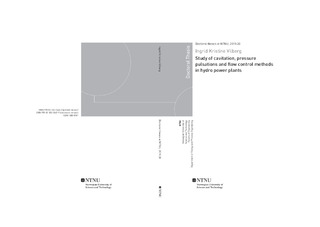| dc.contributor.advisor | Nielsen, Torbjørn Kristian | |
| dc.contributor.advisor | Kjeldsen, Morten | |
| dc.contributor.author | Vilberg, Ingrid Kristine | |
| dc.date.accessioned | 2019-02-01T13:01:59Z | |
| dc.date.available | 2019-02-01T13:01:59Z | |
| dc.date.issued | 2019 | |
| dc.identifier.isbn | 978-82-326-3667-9 | |
| dc.identifier.issn | 1503-8181 | |
| dc.identifier.uri | http://hdl.handle.net/11250/2583517 | |
| dc.description.abstract | Hydro power plants play an important role in balancing power supply and maintaining a constant grid frequency. With the large water storage capacity, hydro power is in a favourable position with regard to operational flexibility to balance intermittent renewable energy sources, such as wind and solar power. Operation of Francis turbines outside the best efficiency point leads to draft tube pressure pulsations and cavitation, with unwanted effects like noise, vibration and erosion which cause increased wear and maintenance requirements.
Flow control is a collection of methods and technologies to modify flow conditions and achieve more favourable situations. Air injection in draft tubes is a common flow control method to attenuate pressure pulsations due to increased compression and reduced wave propagation velocity. These effects can also be favourable with regards to elastic waves in long pipe lines, pressure pulsations and water hammers. This thesis studies the use of flow control methods in hydro power plants, with emphasis on air injection. The presented work is focused around three main experiments.
The runner blades at Svorka power plant experienced cavitation erosion, and several measurements were carried out to identify the operational areas with the highest risk of erosive cavitation. By installing plexi-glass windows on the draft tube, we were able to visually correlate the erosion damages and the collapse of cavitation clouds.
The effect of a draft tube water injection system on pressure pulsations and cavitation was also studied at Svorka power plant. At installation, the injection system showed positive effects for mitigation of pressure pulsations. However, results from the study presented in this thesis indicate that the injection system has negligible effect on both cavitation and pressure pulsations. This could be due to the amount of air admitted through the runner shaft and variation in turbine submergence because of uncertainties regarding water level of the river and sedimentation in front of the outlet.
The effect of air injection was further investigated in a cavitation tunnel experiment, where the coupled effect between hydrofoil cavitation shedding and system dynamics of the tunnel with various gas content was in focus. The results showed a correlation between shedding frequency and the pressure dynamics of the tunnel, but the shedding was not affected by the air content of the tunnel. Nevertheless, such a link might still exist and could possibly be detected by using a different experimental approach.
The aim of the last experiment was to assess the transient characteristics of a 1400 m pipe line to evaluate the wave propagation velocity and air content of the pipe. This was carried out by creating water hammers in the system. Furthermore, standing waves were created in the pipes by using a rotating valve apparatus to vary the pipe outlet area and impose periodical variations of flow rate and pressure. A more comprehensive and improved experiment will be planned based on the results and experiences from this study.
Collectively, these experiments show that the presence of gas can affect wave propagation velocity and elastic waves, if uniformly distributed. However, the gas can also accumulate in pockets and define a new dynamic element in the system. Gas injection can be used as a flow control method, but it should be taken into account that the gas can collect and create accumulators in the system which can improve or decrease system performance. | nb_NO |
| dc.language.iso | eng | nb_NO |
| dc.publisher | NTNU | nb_NO |
| dc.relation.ispartofseries | Doctoral theses at NTNU;2019:30 | |
| dc.relation.haspart | Paper 1: Assessment of remote cavitation detection methods with flow visualization in a fullscale Francis turbine X. Escaler, I.K. Vilberg, J.V. Ekanger, H.H. Francke, M. Kjeldsen Published in Proceedings of the 10th International Symposium of Cavitation (CAV2018) | nb_NO |
| dc.relation.haspart | Paper 2: Influence of draft tube water injection system on cavitation behaviour in a full-scale Francis turbine with visual access I.K. Vilberg, M. Kjeldsen, X. Escaler, J.V. Ekanger, T.K.Nielsen Published in Proceedings of the 29th IAHR Symposium on Hydraulic Machinery and Systems | nb_NO |
| dc.relation.haspart | Paper 3: The effect of gas content on cavitation shedding and test facility dynamics I.K. Vilberg, M. Kjeldsen, R.E.A. Arndt, T.K. Nielsen Published in Proceedings of the 10th International Symposium of Cavitation (CAV2018) | nb_NO |
| dc.relation.haspart | Paper 4: Experimental assessment of pressure pulsations and transient characteristics of a 1400 m pipe line I.K. Vilberg, M. Kjeldsen, B. Svingen, T.K. Nielsen Published in Proceedings of the 13th International Conference on Pressure Surges | nb_NO |
| dc.title | Study of cavitation, pressure pulsations and flow control methods in hydro power plants | nb_NO |
| dc.type | Doctoral thesis | nb_NO |
| dc.subject.nsi | VDP::Technology: 500::Environmental engineering: 610 | nb_NO |
